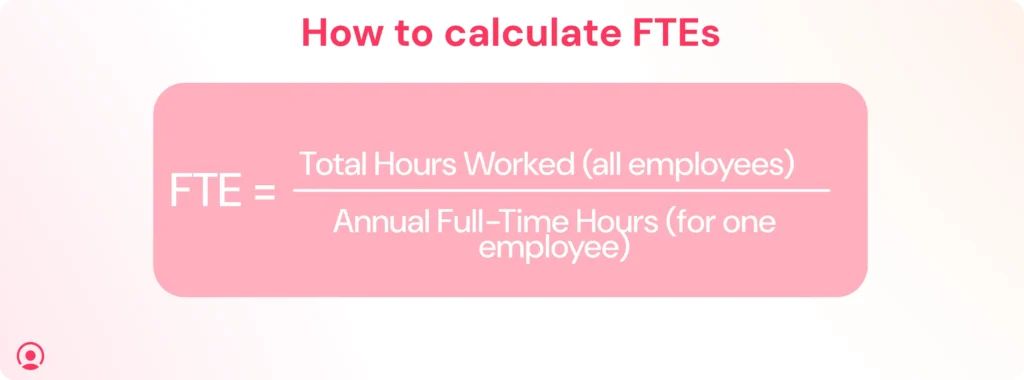What is the productive capacity of your company? In other words, do you know what the full time equivalent is and how it can help you better understand your organisation’s needs?
Using the full time equivalent calculation, it’s possible to identify crucial organisational needs, like whether your company needs to restructure, hire or reduce staff. The FTE is therefore an HR indicator that’s integral to the success of the department and the organisation as a whole.
📌 Calculate your team’s full-time equivalent (FTE) with our free calculator.
What is Full Time Equivalent?
The full time equivalent, or ‘FTE’, is a unit of measurement that reflects an employee’s productive capacity. It is used to determine the number of full-time hours that all employees within a business have worked. The full-time equivalent converts the hours worked by part-time employees into hours worked by full-time employees.
For example, an FTE calculation of 1.0 corresponds to the hours worked in a day for a full-time employee. In most sectors, typically, a full-time employee works 2,800 hours. Whereas, the FTE for a part-time employee working 20 hours a week would be 0.5. This helps standardize work hours and compares part-time and full-time roles effectively.
These indexes are crucial for strategic Human Resources management as they highlight the productivity of a company. In other words, they allow you to calculate the performance of a team, department or entire organisation.
What is the Purpose of Calculating FTE?
The conversion of part-time employees into full-time employees provides information on the productivity of the company’s workers, whether by team or department. This has several advantages:
- Boosts performance analysis: Companies get greater insight into employee performance. Understanding this is more important than knowing the total number of employees or hours per week each employee works.
- Supports HR management: Important HR decisions can be made using the full time equivalent (fte), especially in terms of people management planning. The most urgent changes in teams and trends in the job market can be better assessed.
- Makes it easier to plan projects: Employees with different types of employment contracts (e.g. a full time worker and those on part-time hours) can be more easily assigned to projects by project managers, as an employee’s performance can be calculated more accurately, no matter how many hours per week they work.
- Improves compliance: FTE can determine which labour laws apply within a company. For example, in the UK, employers must follow automatic enrolment pension duties and payroll thresholds.
- Increases comparison accuracy: The productive capacities of different companies and departments can be compared more easily with FTE, as well as the productivity of a part-time worker vs. full-time workers.
- Reduces costs: Working out the full-time equivalent (FTE) of a company can help in identifying opportunities to reduce labor costs through resource optimisation, identifying outsourcing opportunities, reevaluating employee salaries and workforce planning, and budgeting.
How Do You Calculate Full-Time Equivalent?
You can easily calculate FTE using the formula and four steps listed below.
First, bear this in mind. Based on an FTE of 1.0, we calculate employees work 2,080 hours per year. This does not include holidays and days of absence. This value is used only as a basis for calculating the annual FTE and reflects the hours of an employee who works 5 days a week, 8 hours a day.
*Always calculate your FTE based on your organisation’s defined full-time hours. For example, if your company policy states full-time is 37.5 hours per week vs. 40 hours per week.

Full Time Equivalent (FTE) Calculator Formula
It is possible to calculate the full time equivalent using the following simple formula:
(Total number of hours for all part-time employees + the total number of hours for all full-time employees) / period for calculation (2080 for annual FTE, 173.33 for monthly FTE or 8 for daily FTE ) = Final FTE
Using this formula, follow these 4 steps:
Step 1
First, it is necessary to determine the number of hours worked by part-time employees (i.e. part time FTE).
Formula:
Part-time employees x weekly hours x number of weeks (that an employee has worked) = total hours worked over the given time period
Example:
5 part-time employees work 25 hours a week for 30 weeks.
2 part-time employees work 10 hours a week for 25 weeks.
Account:
5 x 25 x 30 = 3750 hours
2 x 10 x 25 = 500 hours
To obtain the total number of hours worked by all part-time employees, add the two results together:
3750 + 500 = 4250 part-time
Step 2
Now determine the number of hours worked by full-time employees over a given period (i.e. full time FTE). Full-time employees are those who work full time schedule, i.e. a minimum of 30 and a maximum of 40 hours per week and more than 120 days a year. Use each employee’s scheduled hours for your calculation.
Formula:
Full-time employees x working hours per week (40) x 52 weeks per year = total working hours of full-time employees per year (or ‘annual hours worked’)
Example:
7 full-time employees work 40 hours a week
Account:
7 x 40 x 52 = 14,560 hours full time
Step 3
Now add the total number of hours worked by full-time employees to that of part-time workers to get the total number of hours for all employees.
Formula:
Total hours of full-time employees + total hours of part-time employees = total hours worked by all employees per year
Account:
4250 (part-time) + 14,560 (full-time) = 18,810 total hours
Step 4
In the last step, simply divide the total number of hours of full-time employees and part-time employees (in our example 410 hours) by the number of regular full-time hours (in our example 2,080 hours per year or 40 hours x 52 weeks ) to calculate the full time equivalent for a certain period of time.
Formula:
Total number of hours for all employees / 2080 = FTE
Account:
18,810 (total number of hours) / 2,080 = 9.04 FTE
To obtain the full time equivalent for a month, divide the total number of hours by 173.33 (2,080 hours / 12 months).
For example, if the total number of hours in the month of March were 2,800, the account would look like this:
2,800 (total number of hours) / 173.33 = 16.15 FTE (FTE)
To find the equivalent of a full-time day, divide the total number of hours by 8.
For example, if the total number of hours were 75, the calculation would look like this:
75 (total number of hours) / 8 = 9.38 FTE (FTE)
The result is the full-time equivalent of 9.04. With 14 employees, 7 full-time and 7 part-time, the staffing capacity is 9.04 full-time employees per year.
FTE Example Calculation
10 people are employed in a company. Five of them work full-time (40 hours per week), three occupy a part-time position each working 20 hours a week and the other two each work 10 hours per week. The FTE or FTE value, in this case, is 7.0.
The full time equivalent calculation:
A full-time position corresponds to an FTE calculation of 1.0. Accordingly, 5 full-time positions result in an FTE of 5.0.
A part-time position (20 hours) corresponds to an FTE of 0.5. With three part-time positions, this results in a value of 1.5.
10 hours per week correspond to an FTE of 0.25. With two 10-hour digits, this results in an FTE value of 0.5.
As you can see, the part-time employees are converted into the performance of a full-time employee. So, the FTE calculation does not indicate the number of employees in a company, but the equivalent of a full-time employee.
Free FTE Calculator Template
You can use our free FTE template to easily work out your company’s full time equivalent.
Just indicate how many employees work at your company, how many actual hours they work a week and for how many weeks. Our model will then instantly calculate the full time equivalent for you.
Full Time Equivalent (FTE) FAQs
What is the difference between FTE and headcount?
FTE refers to the total equivalent number of full-time employees, which includes part-time work, while headcount refers to the actual number of employees at your company.
How can FTE impact workforce budgeting?
FTE is a crucial number to understand, as it helps to accurately measure and allocate resources accordingly. In addition, it helps managers and HR professionals manage payroll efficiently for both full-time and part-time employees.
Why is calculating FTE important for compliance?
To comply with certain regulations, such as healthcare and tax laws, companies need to report to FTE to determine eligibility for benefits and other mandates.


